
March 15, 2008
Develop Your Own Toolbox
This issue concentrates on tools and resources that most modelers will find helpful to have handy. When it comes to these home-made tools, I only wish I had been aware of them before going out and buying manufactured replacements.
That is why a major portion of this issue is devoted to providing readers with off-site links. Caution: with most of these forums you will be better off checking in when you get the urge as opposed to being automatically notified when someone has posted an entry. You can get a full mailbox awfully fast.
So take a moment to check out the links provided here and Bookmark the ones you find fill your needs
Newest Wiki On The Modeling Scene
If you are an N Scale model railroader here is a chance to share what you know and learn from others in a brand new (by Internet standards) resource dedicated to model railroading, the three-week old Model Trains Wiki The Wiki currently has over 180 users and 400 pages of information on model railroading. The trouble is, according to Brian Groover who created the project, “Right now, there is very little N Scale content on the Wiki -- the S Scale people are way ahead of you. You are the experts, here. It won't take much effort at all to repost some old content, for the benefit of all”.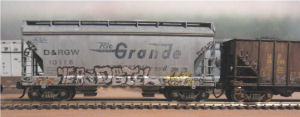
If railroad modeling turns your crank, you really should check out the Wiki as a source for everything you ever wanted to know about model railroading and therefore a good place to post your successes and even some of your failures.
Everyone admires success and well they should, but we also learn from mistakes, our own and those shared by others.
I intend to produce some tutorials on DIY (Paper) Contracting and some of my early efforts…well.
The objective of this Wiki is to create one place where people asking questions in the group can get specific answers to model railroading questions
Junk Makes Fascinating A Diorama
Yes, there is one decent windshield, see if you can find it.This YouTube tour of a 1/25th modeler’s imaginative junkyard draws rave comments and probably accolades from judges. It sure beats putting unused RC cars away in a drawer or leaving them to collect dust on a shelf.
When he posted it back in August, Pete in Forth Worth said, “I build a small Junk Scenery in G-Scale. Watch the details.”
You Know The Year Is 2008 When…
This one is a little off the beaten track but my email inbox gets more than scale modeling info and this one I'd like to share.How do you know what year it is? You know the year is 2008 when...
1. You accidentally enter your password on the microwave.2. You haven’t played solitaire using a deck of cards in years.
3. You have a list of 15 phone numbers to reach your family of three.
4. You e-mail the person who works at the desk next to you.
5. Your reason for not staying in touch with friends and family is that they don’t have e-mail addresses.
6. You pull up in your own driveway and use your cell phone to see if anyone is home to help you carry in the groceries.
7. Every commercial on television has a web site at the bottom of the screen.
8. Leaving the house without your cell phone, which you didn’t have the first 20 or 30 (or 60) years of your life, is now a cause for panic and you turn around to go and get it.
9. You get up in the morning and go on line before getting your coffee.
10. You start tilting your head sideways to smile. : )
11. You’re reading this and nodding and laughing.
12. Even worse, you know exactly to whom you are going to forward this message.
13. You are too busy to notice there was no #9 on this list.
14. You actually scrolled back up to check that there wasn’t a #9 on this list.
15. Your gas money for a trip to the library exceeds your Internet usage fees for the week.
A Jig For Duplicating Trestle Bents
Got an idea this morning I just couldn’t wait to share and I’ve got the March issue of Scale Modeling Tips & Tools Monthly going out in six hours so you get to be among the 400 first to get and try it.Admittedly it is not polished and perfected, but it is good enough to solve my need for a support trestle for the billboard I am planning to rooftop mount on my paper version of Slim’s Café.
This trestle jig is unique in that it can be reused for a variety of different trestle requirements. As currently construed, it is limited to a trestle bent 60 feet high in N Scale.
What makes this a unique jig is its base. I chose a clear cover CD case.
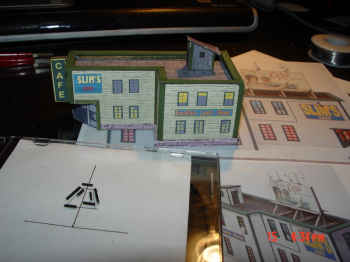 I draw the base span of the trestle near the bottom of a 4.5” by 4.25” piece of white paper along with a centerline vertical. Next I measure the length of the base needed (for the billboard the base is 9 feet in length. Then I draw the supports for the painter’s walkway at the base of the billboard.
I draw the base span of the trestle near the bottom of a 4.5” by 4.25” piece of white paper along with a centerline vertical. Next I measure the length of the base needed (for the billboard the base is 9 feet in length. Then I draw the supports for the painter’s walkway at the base of the billboard.
Once the lines are drawn, close the CD case with the line drawing facing the clear cover.
Use care in placing the upright guides on the CE cover adjacent to the lines of your drawing. Important: Use white, water soluble all purpose glue to adhere your guides to the plastic cover. I placed the long guides first and let them harden so I can drop an actual piece of the upright stock alongside to properly space the shorter guide.
Now place guides for the horizontals in the same manner.
Let the glue cure, but there is no reason to let it set more than an hour before use.
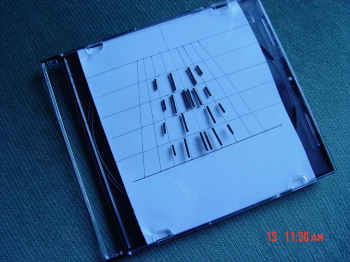 The beauty of the CD cover trestle jig is the ability to use it for other supports where you need an easy to duplicate “bent” such as trestles, water tank supports, bridge supports.
The beauty of the CD cover trestle jig is the ability to use it for other supports where you need an easy to duplicate “bent” such as trestles, water tank supports, bridge supports.
The same system can be used whether you are working with strip wood or plastic strips.
Once I finish the billboard base I’ll chip off the guides and wash the glue residue off the cover and it is ready for another project.
To reuse, I just draw up a new layout to insert in the CD case. .
Use Model Cost Cutters
Save For The Big Kit
You can always go out and buy a solution to any problem and cutting precise angles whether you are working with sheet stock or strip woods can become one of those problems that can set you back half the price of a good kit to solve.
Remember that Uncle Remus “saw”, “It is what you do with what you got that pays off in the end.
Here are a couple of cutting tools worthy of taking the time to piece together.
45-degree angle clamp
This is from Chris Dowie in Canada, a frequent poster on the Railroad Line Forums.
Depending of the stock you have available to make this clamp, you can work with sizes up to four or six inches in width,
This clamp pivots where you see the one screw. It is made from a scrap piece of 4" x 4" cedar post and a couple of bits of 3/4" plywood. there is a wedge that goes in the back to hold the clamp tight.
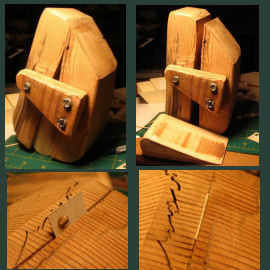 The inside jaw of the clamp has a flat part that mates with the other halve that is about 1" wide. From that flat there is a 45 degree angle drawn on the wood and cut, so then the working surface of the clamp is a 45 degree angle from the flat clamping surface. Clamp a bit of card in there and sand it to a perfect 45 degree angle.
The inside jaw of the clamp has a flat part that mates with the other halve that is about 1" wide. From that flat there is a 45 degree angle drawn on the wood and cut, so then the working surface of the clamp is a 45 degree angle from the flat clamping surface. Clamp a bit of card in there and sand it to a perfect 45 degree angle.
Chris cautioned, “You would need a scrap the same thickness as the stock you want to miter clamped in the jaws and then scribe the 45 degree angle on the clamp and cut it out and sand it smooth with the scrap stock clamped in place.”
Mini Miter Gets The Angle Right
Here’s an idea from another Canadian, Hubert Sicard of Wooden Ship Modeling for Dummies fame: Build your own “Mini Miter”.
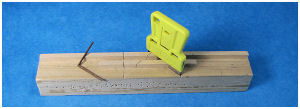
To build it you will need some scrap lumber, preferably 1 inch by 1 inch about 8 inches in length and a couple of strips that measure 3/16ths by 3/16ths one about two inches in length and the other about four inches.
You will need a router to gouge a slot about 5/16ths in width out of your 8" stock. Carefully tack nail your 3/16ths strips into the slot as pictured. Now use a fine-toothed razor saw and cut a 90-degree slot through the shorter 3/16th strip for cutting accurate dimensional lengths.
Now for the angle. Accurately draw two opposing 45-degree angle lines in the longer strip (See picture). It is not a bad idea to check the angles from both sides as this will be your master. Once you are sure the lines are right, cut the slots with the razor saw.
You will find a razor blade holder like the yellow one in the picture to be a lot more user friendly than the blades themselves, but sharp razor blades will allow you to do neat work without crushing the stripwood.
Glue and Needles To Make It Stick
All modeling, sooner or later, boils down to your ability to stick one thing to another and working with wood is probably one of the most important whether you are gluing strips under stress (curved hull planks in ship modeling) or putting together two walls at a right angle.For my money the best adhesive for wood applications is Carpenter’s Glue and certainly one of the best is LePage’s with a lineage of over 130 years dating back to its invention in Gloucester, MA by William N. LePage, a 19th century “Captain of Industry” who also invented the holster.
 Both LePage’s and Elmer’s produce a carpenter’s glue with clear advantages over the more chemical intense Cyanoacrylates, epoxies and ‘Super Glues”.
Both LePage’s and Elmer’s produce a carpenter’s glue with clear advantages over the more chemical intense Cyanoacrylates, epoxies and ‘Super Glues”.
• They are excellent for wood to wood applications,
• They dry hard and quickly
• They are good glues for joints that don’t fit tightly
Carpenter’s glues also work well when using a syringe as an applicator which allows you to apply your adhesive with much more accuracy because of the fine tip of the needle and the minute amount of liquid dispensed.
If you take the time to clean the needle after each use (with carpenters glue just run some warm water through it) you can easily get three or four months use out of the needle. Needles are available in boxes of 50 for about $7 in most drugstores.
Incidentally, if you are gluing with a syringe, there is no need to squirt it up in the air to clear air bubbles.
You can take one more step to prevent them from clogging, store them point down on a piece of wet sponge.
Modeling College at your fingertips
Whatever your modeling niche railroading, ship modeling, RC, dioramas or static model cars, you will find the Internet offers a whopper of a resource through Web forums, message boards and discussion groups that dovetail your interests.There are also a large number of sites similar to
My site devoted to helping modelers improve their skills.
I have found hobbyists who use the forums and discussion groups to be among the friendliest and helpful sources of good, practical information.
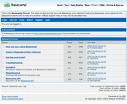 These sites are very informative and most offer a tremendous archive of model photos in various stages of completion. It is like having a modeling club right in your living room.
These sites are very informative and most offer a tremendous archive of model photos in various stages of completion. It is like having a modeling club right in your living room.
They are virtually a community of regular users who often visit daily to review information and add their comments or post photos and files.
You will find most of these groups allow you to surf through in anonymity, but the most advantages go to those who register with a user name and password giving them additional privileges such as editing their previous posts, starting new topics and controlling their own settings.
These sites bring together people from around the world with similar interests and levels of experience who share a passion. Most forums and user groups have administrators or moderators who can edit, delete or modify any entry, ban, delete or create members. They monitor the “netiquette” of those who post. Forum netiquette can vary on different forums. On default, individuals must agree to a Registry Agreement that defines a forum's rules before joining that particular forum, but whether those rules are actively enforced varies from forum to forum. For example, a hobby forums generally prohibit sexually explicit content. Typically, they do not tolerate cursing and rude behavior.
Activities to avoid include:
Multiple Posts—Posting the same message twice is normally considered a faux pas. Repeating this form of abuse will normally attract administrative action.
Spamming—Spamming a board is generally considered repeating the same word or phrase over and over—usually a willful act with malicious intent. This is a good way to get banned.
Trolls—A troll willfully and repeatedly disregards netiquette, often posting offensive comments or derogatory postings. A sure way to get deleted or edited.